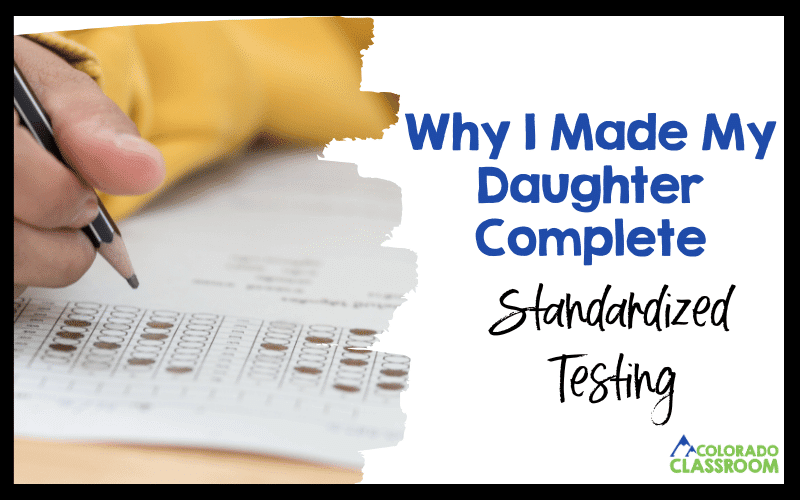Why I Made My Daughter Complete Standardized Testing
When I was teaching full-time, I had plenty of opinions about standardized testing. After stepping out of the classroom, I had to face something a little uncomfortable. I was still arguing about a system that had completely changed. I was doing it without any firsthand experience with the newest version of the test. It felt a bit like arguing about skydiving when you’ve never actually jumped. You can share what you’ve heard about the fear, the danger, or the adrenaline… but you don’t truly understand it until you’re the one standing in the open door of the plane.

That realization hit me hard, especially when conversations about Colorado’s newly updated statewide test started circulating. Teachers were talking about how different it felt, parents were unsure of what to expect, and the entire system just seemed far removed from what I once knew. I suddenly wasn’t confident that my old perspective still held weight. I knew I needed to rethink how I was approaching the entire topic of standardized testing. I could either continue talking about what I thought I knew, or I could experience it from a different point of view. One that would give me updated insight into the system as it exists today.
Why I’m Sharing My Standardized Testing Experience

Instead of continuing to rely on secondhand information, I decided to get a fresh perspective. I wanted to understand how the current standardized testing system functioned, not as a teacher proctoring the exam, but as a parent watching the entire process unfold with my own child. That shift completely changed how I viewed the experience. It allowed me to see the testing process in a quieter, more observant way than I ever could during my classroom years.
Watching my daughter go through the test helped me notice things I never saw when I was rushing around a classroom checking headphones, troubleshooting login screens, or reminding my kids to take deep breaths. It made the experience feel more personal and also more revealing. I found myself paying attention to her body language, her attitude, and her emotional state in ways I never had time to observe when I was managing twenty-five kids at once.
That’s why I’m sharing this story now. I may no longer be in the classroom, but I still care deeply about the way standardized testing affects kids, families, and teachers. Having my daughter take the test gave me the updated lens I needed to speak about it honestly. Both the frustration and the clarity that came with seeing it from the outside looking in.
Setting the Stage for Standardized Testing

When I left my teaching position, I thought I had officially stepped away from the whirlwind of standardized testing. I’d administered more than enough tests in my career to know how draining that season could be. Soon after I stepped out of the classroom, Colorado rolled out a completely redesigned state test. Suddenly, the test I had once known so well wasn’t the same test anymore.
I kept hearing conversations about how developmentally off-base it felt, how the questions didn’t always match what our kids were learning, and how the expectations seemed dramatically different. Since I hadn’t given the new test version myself, I didn’t have firsthand context. I couldn’t say whether those concerns were accurate or exaggerated. I missed having real data, real observations, and real experiences to pull from.
So I decided I needed to understand the newest version of standardized testing from a different angle. If I wasn’t going to experience it as a teacher, I would experience it as a parent. I wanted to see how it impacted our students, how it was delivered, and how my daughter reacted to it. I wanted to observe the process with fresh eyes so my opinions would be rooted in current reality. Not the testing system from years ago.
How My Daughter Approached Standardized Testing

One of the reasons I felt confident opting my daughter in was because of who she is and how she approaches challenges. She’s not an anxious test-taker, nor is she a student who shuts down under pressure. She’s an independent, steady learner who works hard, trusts herself, and shows up every day ready to do well. I knew she would handle standardized testing with calm focus rather than panic or defiance.
Sure enough, she went into the testing week exactly as I expected. No drama, no dread, and no spiraling questions about what might be on the test. She simply walked into the testing room, completed the exam, and then went right back to living her life as a happy, healthy teenager. She didn’t analyze every question in the car afterward or worry about how she performed. Testing wasn’t something she carried with her emotionally.
Seeing her react this way was eye-opening. In the classroom, I’d seen students experience everything from tears to frustration to complete overwhelm during standardized testing. Watching my daughter feel completely neutral reminded me just how varied the student experience can be. Some of our kids walk away unaffected, while others are deeply impacted. This difference matters when we talk about testing results, because the emotional side of testing plays a much bigger role than people realize.
The Emotional Side of Standardized Testing
While my daughter breezed through standardized testing without hesitation, many of our students experience the opposite. As a former teacher, I’ve seen students walk into testing day with knots in their stomachs, worried that their score determines their intelligence or their worth. Some of our students internalize test results so deeply that they carry the weight of test season long after it’s over. That emotional impact stays with them far more than we realize.

We feel this emotional pressure as well. We’re the ones trying to calm our anxious students, offer reassurance, and maintain a supportive atmosphere, even when we feel the weight of testing expectations themselves. The emotional tone of the classroom shifts under the demands of standardized testing. We have to navigate those feelings while still delivering instruction and encouragement.
Seeing the contrast between my daughter’s experience and what I witnessed as a teacher underscored how important it is to acknowledge the emotional side of standardized testing. Our kids aren’t just taking a test. They’re navigating stress, expectations, and sometimes fear. Recognizing this emotional reality helps us better understand the true impact standardized testing has on students, and why the conversation around testing needs to include far more than just scores.
How Standardized Testing Impacts Classroom Instruction

When I think back on my teaching years, standardized testing shaped far more than just one week of the school calendar. It influenced pacing guides, forced us to move faster than necessary, and often dictated when certain units had to be taught. Even when I tried to create a smooth classroom rhythm, standardized testing had a sneaky way of shifting my plans. It’s hard to build momentum in a unit when you know everything is about to be paused for test prep.
Testing season also meant rearranging the school day in ways that pulled away from hands-on learning. Specialists were rescheduled. Computer labs shut down for weeks. Small group instruction disappeared as we all monitored practice sessions or prepared our students for the testing platform. The energy in the building changed, too. Hallways grew silent, our kids were reminded constantly to be quiet, and we felt the pressure rising with every passing day.
All of that preparation, and all of those disruptions, often came down to a test that couldn’t fully capture the depth of what our students had learned throughout the year. Experiencing standardized testing from the parent side reminded me how much instructional time gets sacrificed. It also made me think about how much more meaningful the school year could feel if the focus stayed on authentic learning rather than test-based pacing.
Why I Opted In My Daughter

I didn’t opt my daughter into standardized testing because I suddenly became a fan of it. I wanted the results because I suspected they wouldn’t align with who she is or what she can do. Honestly, that’s exactly what I needed. I wanted real data that could either confirm or challenge what people were saying about the new assessment.
I had heard everything from “the questions feel above grade level” to “the results don’t match what students demonstrate in class.” Without my own child’s results, I didn’t have anything concrete to compare. I couldn’t confidently discuss the accuracy or inaccuracy of the test because I didn’t have firsthand evidence. Watching my daughter take the test and waiting for the results allowed me to gather real information instead of relying on assumptions.
If her scores came back showing she was unprepared for the next grade, despite knowing her true capabilities, that would say more about the test than about her. If the scores aligned with what I knew, that would give me insight, too. Either way, I wanted to speak about standardized testing with clarity and confidence, not frustration and guesswork.
What I Learned After the Standardized Testing Season
When fall arrived, I expected there to be a big discussion about the previous year’s standardized testing results. I thought the school might share data with families or analyze trends with teachers. Instead, the scores barely surfaced. It almost felt like the test had never happened at all. For something that took so much time and energy, the lack of follow-up was surprising.

That silence made me rethink how standardized testing is actually used. We lose weeks of instructional time, students go through a long and tedious testing process, and families wait months for results that often don’t carry much weight. The disconnect between the time invested and the value returned made me question whether the current system is really serving anyone in the way it’s intended.
Then, in the most ironic twist, the test changed again just a few years later. After everything our kids and teachers had gone through, the state shifted directions. That change only solidified my belief that standardized testing is not the best measure of learning. Maybe, with the right conversations and advocacy, we can push for something better.
What Standardized Testing Can’t Measure

One of the biggest realizations I had through this process is just how many things standardized testing can’t measure. It doesn’t see a child’s creativity or their ability to think outside the box. It can’t measure communication skills, collaboration, or the quiet determination a student shows when rewriting a paragraph until it truly reflects their best work. It certainly doesn’t capture leadership, kindness, or curiosity. The traits that often matter most.
Standardized testing also misses the richness of academic learning. It can’t measure how well a student participates in discussions, builds arguments, or makes connections across subjects. It doesn’t capture project-based learning, real-world problem-solving, or the growth our students show in their day-to-day work. These moments shape who our students become as learners. Yet, they never appear on a score report.
Seeing my daughter shrug off the test reminded me just how limited the system can be. Her strengths, like her creativity, her independence, and her thoughtful reasoning, aren’t things a test can measure. I know that’s true for countless students. Standardized testing offers a single snapshot. The full picture of who a child is can only be seen in the everyday learning experiences that teachers work so hard to create.
Ready for More Meaningful Alternatives to Standardized Testing?
If you’re looking for assessment tools that actually show what your students know, far beyond what standardized testing can measure, you’ll love exploring the formative assessments I’ve created for social studies. They’re designed to give you clear, authentic insight into your students’ understanding, whether you’re teaching Colorado History or diving into Ancient Civilizations.
These formative assessments were always the backbone of my instruction because they helped me see real learning happening day by day. Not just on a computer screen in the spring. If you’re ready to make your assessment process more supportive, engaging, and meaningful, explore the options available in my TPT store.
You can browse all of my social studies formative assessments, along with tons of other resources that help you teach confidently without relying solely on standardized testing. They’re classroom-tested, kid-friendly, and designed to make your teaching life easier.


